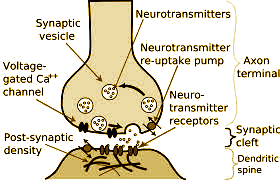 In the waning decades of the last century, no psychiatric lecturer worth his/her salt failed to include some version of the slide on the right at some point in every presentation. The labels may have varied [catecholamines, dopamine, serotonin], but the slide was eternal. It was the era of the neurotransmitters. At the time, I called it the NIMH Memorial Neuron, joking, "don’t leave home without it."
In the waning decades of the last century, no psychiatric lecturer worth his/her salt failed to include some version of the slide on the right at some point in every presentation. The labels may have varied [catecholamines, dopamine, serotonin], but the slide was eternal. It was the era of the neurotransmitters. At the time, I called it the NIMH Memorial Neuron, joking, "don’t leave home without it."
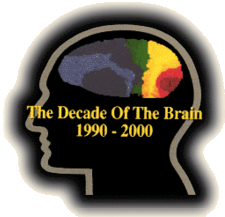 The 90s were declared the Decade of the Brain, but I think of it as the Serotonin years because that seemed to be what everyone talked about – SSRIs and SNRIs. And if there was a must-have slide for the 90s, it would have to be one of the ubiquitous clinical trial graphs – just fill in any drug in the one below right:
The 90s were declared the Decade of the Brain, but I think of it as the Serotonin years because that seemed to be what everyone talked about – SSRIs and SNRIs. And if there was a must-have slide for the 90s, it would have to be one of the ubiquitous clinical trial graphs – just fill in any drug in the one below right:
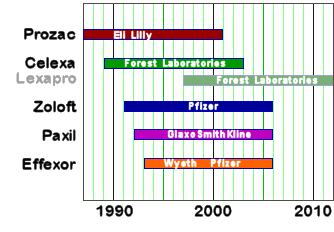
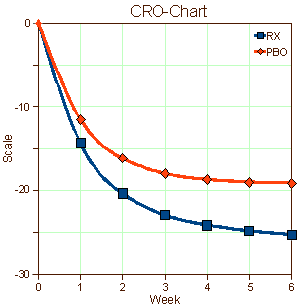
Then halfway through the 90s, along came the Atypical Antipsychotics picking up where the SSRIs/SNRIs left off. The pipeline was flowing on into the early 2000s:
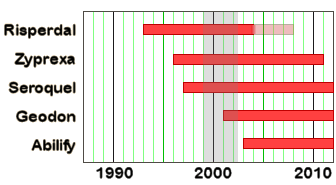
The point of this little review is that something happened in the early 2000s that had a profound impact on the decade. Buoyed by the seemingly endless flow of new drugs, the non-invasive fMRI neuroimaging technique of Ogawa [BOLD], the completion of the human genome project, and who-knows-whatever-else along the way – what had been previously vague speculative biological hypotheses were elevated to the level of basic truths awaiting confirmation – and the march towards proof was underway. There were two official channels available for such a move: the National Institute of Health [NIMH] and the American Psychiatric Association [APA].
In this commentary, we argue that psychiatry’s impact on public health will require that mental disorders be understood and treated as brain disorders. In the past, mental disorders were defined by the absence of a so-called organic lesion. Mental disorders became neurological disorders at the moment a lesion was found. With the advent of functional neuroimaging, patterns of regional brain activity associated with normal and pathological mental experience can be visualized, including detection of abnormal activity in brain circuits in the absence of an identifiable structural lesion. If mental disorders are brain disorders, then the basic sciences of psychiatry must include neuroscience and genomics and the training of psychiatrists in the future needs to be profoundly different from what it has been in the past.
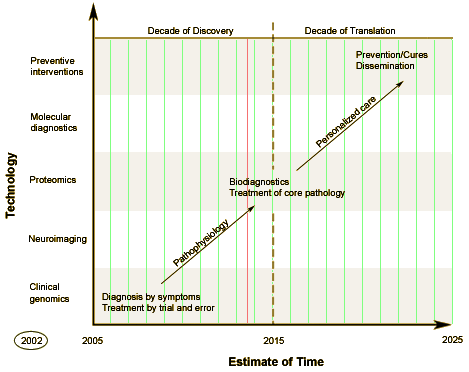
It is our hope and expectation that through advances in animal models, genetics, neuroimaging, and postmortem investigations psychiatry will ultimately have a diagnostic system based on etiology and pathophysiology. Such a system should result in reliable and valid diagnosis, more specific and effective treatments, and therapeutic strategies to delay and even prevent the development of psychiatric disorders.
This pair of initiatives [NIMH’s clinical neuroscience and APA’s DSM-5] were both presumptuous and risky: presumptuous because their biological hypotheses were still speculative even after the Decade of the Brain; and risky because they were betting on success with an exposed hand [I put a red line on Insel’s map to mark the present]. Neither gambit paid off. So we enter the fourth decade of the modern era absent the kind of proof both of these initiatives promised for current directions.
 But in this case, there’s something out of alignment in both aspects of the process. Both the academic and professional arms felt a pressing need to define the causes [and treatment] of illnesses within the domain of psychiatry – the mental illnesses – following their current trajectory. I would propose that in both cases, they are not leading but following. And what they’re following are the definitions of what is "illness" and what is "medical" handed out by the Insurance Industry and the Pharmaceutical Industry. It’s time for some major soul-searching, not plunging ahead into a fourth decade with the same old banners…
But in this case, there’s something out of alignment in both aspects of the process. Both the academic and professional arms felt a pressing need to define the causes [and treatment] of illnesses within the domain of psychiatry – the mental illnesses – following their current trajectory. I would propose that in both cases, they are not leading but following. And what they’re following are the definitions of what is "illness" and what is "medical" handed out by the Insurance Industry and the Pharmaceutical Industry. It’s time for some major soul-searching, not plunging ahead into a fourth decade with the same old banners…
In his historic 1961 farewell speech on the military-industrial complex, Dwight Eisenhower warned that this consortium paradoxically created risk for national security because both sides committed to flawed paradigms out of perverse incentives and misguided self-interest. He warned similarly about the corruption of original research by the academic-government complex. Now we are seeing the same themes play out in psychiatric research. The consortium now is the Federal government (NIMH) plus the pharmaceutical industry plus the academics. Every few years a new mantra is adopted – genomics, connectomics, proteomics, you name it – the purpose of which is to reassure the players that they actually know what they are doing. Besides Thomas Insel, another master of this hand waving is Steven Hyman, former director of NIMH. Trouble is, when they preach to us about translational neuroscience they actually have little to show for it.
John Sadler a psychiatrist philospher from University of Texas. Has written an eloquent chapter on the Pharma industrial complex.
Dr. Sadler is at UT Southwestern and I recommend everything he has written.
Why was Insel a surprise choice?
Whenever MRIs are brought up as the golden key to the mysteries of mental illness having to be the result of physiological brain dysfunction that is genetically determined no matter what rock it’s hiding under, one only need say “empathetic salmon”. but it doesn’t hurt to elaborate and to address motive and bias.
http://www.smartplanet.com/blog/pure-genius/q-a-sally-satel-psychiatrist-on-the-flaws-of-brain-research/10361
re: Wiley’s comment:
fMRI Gets Slap in the Face with a Dead Fish
Re Mickey’s comment:
It even won an Ig Nobel (2012 Neuroscience Ig Nobel):
http://www.improbable.com/ig/winners/
See also:
http://blogs.scientificamerican.com/scicurious-brain/2012/09/25/ignobel-prize-in-neuroscience-the-dead-salmon-study/
Sandra,
Insel’s trajectory was moving in a downward direction. In 1994, he was not reappointed to the NIMH intramural program [see As He Worked to Strengthen Ethics Rules, NIMH Director Aided a Leading Transgressor]. He was rescued by Dr. Nemeroff, then “boss of bosses” in Psychiatry who brought Insel to Emory as head of Yerkes Primate Center. People at Yerkes didn’t like Tom [micromanager, controlling said my friends], and he wasn’t reappointed there either. So Nemeroff made him head of a new “Translational” program at Emory. In the Chronicle of Higher Education article above, they speak of Nemeroff’s lobbying for Insel for the NIMH job. It’s hard to remember now, how much power Nemeroff wielded back in those days before his slide beginning in 2004-ish. When Nemeroff got the Chairman’s job in Miami with Insel’s help after being finally canned at Emory, it was widely presumed it was payback [because it was]. Remember how Nemeroff got David Healy axed from the job in Canada in 2000. So, back to your question. As I recall, Insel’s appointment as Director of the NIMH was met with the kind of surprise like “who?”
See also this post and the comments on Danny Carlat’s blog back in the day – Dr. Tom Insel, NIMH Chief, Scolds Psychiatry
I guess one of the most destabilizing developments for the field of psychiatry was the slowly growing ‘evidence base’ from where behavioral neuroscience started to realize ‘pure biological illness’ (like a B-12 deficiency, mercury poisining, or CNS infections) were known to produce symptoms indistiguishable from mental illness, and that these symptoms were mostly random from one person to another.
That threw into question if mental illness really existed, or if there were just enough mental disorders that people who were similiar enough could be sorted into meaningless groups that did not reflect the cause of illness.
The other problem was that if known and treatable biological illness, like B-12 defficnecies, CNS infections, and thryroid dysfuction could produce the same symptoms as metal disorders, but at random, then psychiatric diangosis may be misdiangosing a large portion of people and preventing propper medical care.
As a result, the NIMH chose to go the route of ‘clinical neuroscience’ while the APA’s reaction was to declare their pre-exisiting mental disorders as ‘psycho-biological’ dysfuction in the DSM5.
It’s funny the NIMH met the APA with such strong criticism for that when the NIMH was still operating the exact same way as the APA. THe NIMH is looking for genetic markers for ADHD..
Maybe its not suprising. Psychiatry can’t treat both psychotic patients in an ER and children with behavioral problems (and with the same drugs!) and still be a functional profession grounded in reality or science.
There seems to be a good amount of soul-searching in that regard in papers indexed on pubmed. In fact, the 1970’s are filled with the same articles as the 2000’s, one ‘crisis’ after another. No real soultions though. Meanwhile, the number of people seeking reimbursement for mental health services just keeps increasing. The NIMH and the APA lead no path different then anything that came before.
The world has changed since the 70’s though. What psychiatry’s leadership is doing can’t last forever anymore, it’s becoming too transparent.
It’s true, progress in psychiatry has largely been changes in jargon.